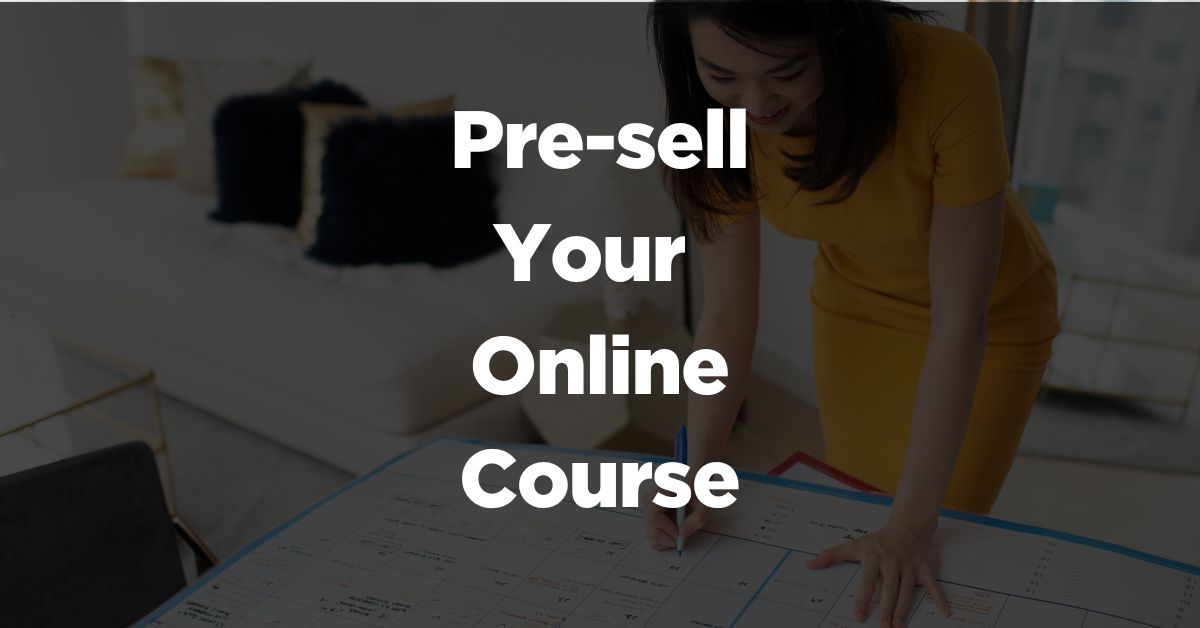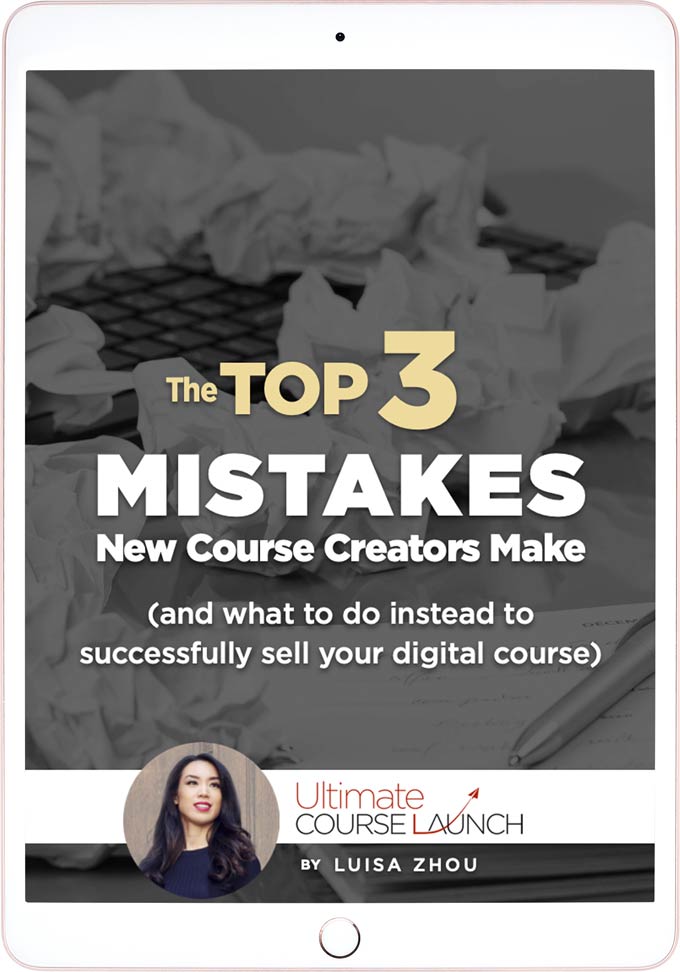Want to pre-sell your online course?
This is the guide for you. In this article, I’ll show you how to pre-sell your course so that you can launch your course faster – without wasting time and money on the wrong type of course.
Read on to learn more.
What does pre-selling your course mean?
Pre-selling online courses means launching one before you’ve fully built out your course.
Can you really do that?
Here’s the thing:
Creating an online course takes time.
You don’t want to invest time in a course idea that’s going to fail.
Pre-selling makes sure you put in as little effort as possible before you validate the idea and earn money from it. Once you know it’s a topic there’s demand for, you can roll out the full online course creation process.
This idea isn’t new – in fact, the startup world uses pre-selling by creating “MVPs” or Minimum Viable Products that are a very basic first version of their product.
As an online course creator, all you need to pre-sell a course is a great course sales page, an attractive course outline and the first module, and a successful launch.
Read on how to start pre-selling, step by step.
How to pre-sell your online course – 10 steps
To pre-sell your course, you need to:
- Come up with a course idea
- Outline your course
- Create the first module
- Price your course
- Create a presale page
- Create your launch funnel
- Start building an audience
- Create a live challenge
- Sell your course
- Deliver your course
Let’s dive in.
1. Come up with a course idea
There is a market for literally every course out there. And the online course industry will be worth $200 billion by 2024.
The best course idea for you comes down to two things:
- What skills do you have?
- What do people want?
Let’s talk about skills first.
Over time, you’ve built up skills from your day job and hobbies.
In short, start with your experience.
This way, you’ll have a course topic that you already have results in.
These could be your own results (you successfully got hired for executive roles) and/or results you helped someone else achieve (you helped a friend get hired for an executive role).
Your experience is the foundation of your course idea.
Then, you need to figure out what people want.
What knowledge are they willing to pay for?
Market research will help you find the answer.
To do market research, start with Google.
Search for your niche and your target audience to see what the top search results are.
For example, as a career coach, you could search for “career advice + ambitious women.”
The top search results will tell you the main pain points your audience is facing.
You could also ask them. Reddit forums, Facebook groups, and even calls with friends, family, or people you meet online (if they qualify) are great ways of asking your audience directly what their main pain points are.
Still stuck? Check out my article on profitable course ideas.
2. Outline your course
Now you have an idea, let’s start outlining your course.
I recommend starting with a First Steps course to make it easier for you to create and sell.
What is a First Steps course?
Basically, it’s a shorter course that covers how to get started toward your student’s ultimate goal.
Example: My first course was called Your First Paying Clients. It’s for new entrepreneurs to achieve the first step of building their businesses – getting clients. That’s a First Step.
Compare this to an A-Z course. My A-Z course, Employee-To-Entrepreneur, teaches people how to go from unfulfilled corporate employees to successful entrepreneurs.
So think about the first steps of your topic. What is the end goal?
From the end goal, work out a step-by-step plan to get there by defining milestones.
The main milestones of your course make up each module.
You can then break down each module into smaller lessons.
Note: it’s not about packing in as much information as possible.
A well-designed course breaks down important information into organized sections.
As a guide, your course should include 4-8 modules. Each module should have no more than 3-7 lessons.
Want more on how to outline your course? Check out this video:
Once you have an outline, creating the content is easy. Let’s talk about the first module – which you’ll need to pre-sell your online course.
3. Create the first module
Here’s a secret: you only need to create the first module to pre-sell your online course.
Let me explain.
If you make all of the course content and it doesn’t sell, you’ve wasted so much time.
But you do need some of the course content ready so that when you pre-sell the course, your first students can get started straight away.
They can also give you feedback that will help you create the rest of the course as they work on the first module.
The first module sets the tone for your whole course. So you want it to be high quality.
After all, with a great first module, your students will be excited to complete the rest of the course.
Now you know why your first module is important, here’s how you create it.
First, the format isn’t that important.
You can do videos, audio, PDF downloads, text, tutorials – whatever fits your course topic.
But generally, courses that use a combination of video and PDF downloads are considered more high-value.
Follow your outline and create the content for the first lessons.
Once you have the first module ready, don’t create the rest of your course.
Instead, we’re going to move on to selling your course to make sure it’s worth creating the rest. See how that works?
Next up: pricing.
4. Price your course
Here’s the thing about pricing: it’s all about the results.
If you can help people achieve the results they want, the price is secondary.
So when pricing your course, think about these three things:
- The value of your results: If your course promises big transformations, it’s more valuable.
- Your ideal customers: Your course needs to be at a price point that your ideal customers can afford. For example, if your course is for college students, it would need to be at a lower cost than a course for high-level corporate executives.
- Your experience/results: If you’re an expert with lots of results, you can charge more for your course.
But there’s one caveat.
If this is your first course, you don’t have that many testimonials or real-life results.You might only have your own back story to show you can help people.
So if you’re in doubt, start on the lower end. You can increase your prices with each launch as you gain more testimonials and perfect your course.
Bottom line: price your first self-study course between $197 and $497.
This discounted price will help your course sell while also giving you a great return on investment.
Now for your sales page.
5. Create a presale page
A presale page is a course landing page that shows people what the course is about and directs them to sign up for updates on when it launches or to buy it.
A great sales page builds excitement for your course and gets them to join your audience or buy your course.
And they are simpler than you might think.
A good presale page has these elements:
Strong headline
The headline of your presale page should have the name of your course and a small tagline about the benefits. This is what grabs your reader so spend time on it.
Example: The tagline for my course Employee-To-Entrepreneur is “The simple, proven, step-by-step blueprint for building a 6-figure service-based business to break free from the 9-to-5.”.
Clear overview of the course
The headline gets the person to read, but the overview or outline convinces the person to buy. Get people interested with a clear hook. Focus on the benefits of your course and the transformation they can expect.
You also want to include the practicalities like the price, the format, and the launch date.
Call to action
The call to action (CTA) asks people to join the waitlist so they can buy the course or be updated on when it launches. Add several “Be the first to know”, “sign up” or “buy now” buttons down your sales page.
Testimonials
Reviews matter. Over 70% of consumers say that online reviews are a deciding factor in their buying decisions. If you have an established business, use the testimonial from your client’s work.
But if you don’t have any testimonials, get a few coaching/consulting clients before you launch your course. Or offer free 15-minute coaching/consulting calls and ask for a testimonial in return.
During these calls, offer valuable advice on your course topic. For example, if your course is about weight loss, you can advise people on how to change their routine which will help them lose weight faster. At the end of your call, you can pitch your course to them as a way to keep working with you.
Once your page is ready, you can build your launch funnel. Let’s talk about it.
6. Create your launch funnel
A launch funnel is a sales system that leads people to your presale page.
It consists of:
- Lead magnet: A free PDF or similar to incentivize people to join your email list.
- Welcome email sequence: An automatic sequence of 4-7 emails that builds a relationship with your audience and encourages people to sign up for your webinar.
- Webinar: A presentation that talks about your course topic and includes a sales pitch for your course at the end.
- Webinar email sequence: A sequence after someone signs up for your webinar.
- Presale page: A page to pre-sell your course, see the previous section.
7. Start building an audience
It’s a myth that you need a massive audience to sell a course.
I sold my first course with a tiny audience. And many of my students come to me with zero audience at all and have success.
But it helps to start nurturing an audience before you launch just to get the ball rolling.
Here are some ideas on how to build an audience:
- Organic social media: Social media is great because you can use it even if you don’t have a big launch budget. Use your smartphone to create content and platforms like Canva to create graphics.
- Podcast interviews: Pitch yourself as a guest host on podcasts in your industry. This will allow you to tap into someone else’s audience and promote your lead magnet to the listeners.
- Partnerships: You can build partnerships with influencers in your industry that can promote your course to their followers. They don’t have to be huge influencers – just creators with an engaged audience that would benefit from your course.
- Paid ads: Paid ads are a fast and effective way of promoting your lead magnet and growing your email list. You’ll need some technical knowledge to make ads work or hire an ads manager to help you.
Once you have a small audience that’s growing, you can start planning your launch event.
8. Create a live challenge
When you pre-sell your first course, you need a launch event.
A great way to launch, grow your audience, and build excitement with your audience is to host a live challenge.
A live challenge is a social media event you create to help your audience achieve a small result related to your course topic.
It gives them a taste of just how much your course could help them.
For example, when I launched Your First Paying Clients, I ran a five-day challenge called Weekend Empire. This was a Facebook challenge where every day I would share a valuable tip to help new entrepreneurs start their businesses.
I hosted the challenge in a closed Facebook group and interacted with people every day.
That built a buzz and also grew my audience.
I explain more about my live challenge strategy in this video:
At the end of the challenge, your audience has achieved a small result and seen how valuable your advice is. So you’re ready to sell your course.
9. Sell your course
After your live challenge is over, post a link to your presale page for your online course.
You might have to publish it a few times over a couple of weeks to encourage people to buy.
Tip: Create urgency.
If you announce that people can buy your course while enrollment is open until X date, people will be more encouraged to buy.
I kept enrollment open for my first course for two weeks. That led to a sold-out course and $8K in sales.
And there you have it! A successful pre-sold course launch.
But that’s just the beginning. Now you need to deliver…
10. Deliver your course
So you pre-sold your course and your students are excited to work on the first module.
While they are working on the first part, you need to create the rest of your course.
I recommend creating a schedule to deliver one module every week or every two weeks.
This keeps the momentum but also gives you a chance to talk to your students.
Their feedback will help you improve your course as you create it.
Ultimately, to me, post-launch is very close to one-on-one coaching if you’re creating your first course.
When I launched my course, I interacted with my students every day.
I answered questions and I celebrated their wins.
It made the course better because I could use the feedback to improve the experience.
And students who feel supported by you are more likely to give you a good testimonial and buy from you in the future.
But it doesn’t stop there. You can use customer feedback to continuously improve your course even as you continue to sell it.
Why should you pre-sell your online course?
Pre-selling your online course helps sell out your course.
Here’s why:
- You can validate your idea: Pre-selling your course helps you get feedback from your audience. This means you don’t waste your time and resources to create a course no one ultimately wants.
- You can offer a better experience to your first students: For a discounted price, your students get a lot of support and engagement from you. That leads to better testimonials and referrals.
- You fund the creation of your online course: Why create your course for free? By pre-selling, you start making money as soon as you’ve created the first module.
- You create urgency and excitement: Your course launch builds anticipation from your audience. That urgency boosts sales.
- You build your audience as you launch your presale: Presales can grow your following by capturing emails for your launch event. Even if the new people in your audience don’t buy the course right away, they might buy from you in the future.
Now let’s talk about where to host your course.
Where can you pre-sell your online course?
Here are the easiest platforms to host your pre-sold course:
- A closed social media group: Facebook groups are great for hosting your first pre-sold course. It doesn’t cost you anything and it creates an intimate space for you to interact with your students. I did this for my first course.
- Your online course website: You don’t need a new website to host your first course. A password-protected page on your own website is fine. If you have a WordPress website, you can use a plugin like AccessAlly to create the first module of your course ready for your students to access.
- A course builder: Teachable, Kajabi, and Thinkific are examples of course builders. These platforms allow you to create your course from scratch using easy drag-and-drop tools.
Bottom line: The platform doesn’t really matter. What matters is the quality of the content and your ability to stay in touch with your students.
The more you interact with your students, the better the experience will be for them.
Next steps
Now you know how to pre-sell your online course.
But this is just the beginning. Some simple mistakes can hold you back from starting an online course business.
I created a free guide to the top 3 course-selling mistakes I see new online course creators make, and how to avoid them. Get it now to learn how you can become a successful online course creator.
Read more:
How to Create a 6-Figure Online Course (+top platforms)
How to Market an Online Course: 60 Proven Ways








